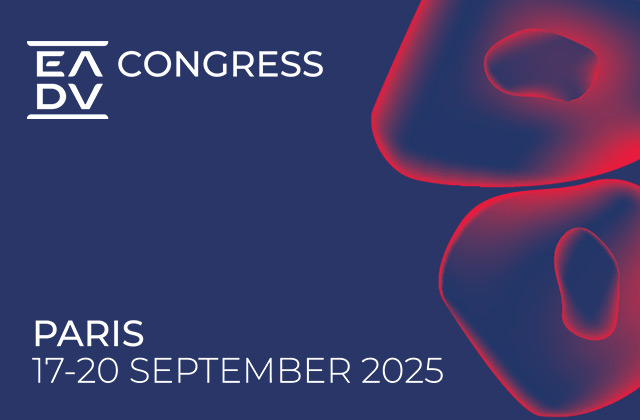
The weather may have been rainy, but it didn’t dampen the enthusiasm of the more than 30,000 people who attended the 2023 ESMO Congress in Madrid, 20-24 October. Members of our team traveled to Madrid to see the latest innovations in oncology research and patient care. While there, we combed through the agenda to find—and attend—the sessions that we thought would be the most interesting and consequential, and then summarize them in this article. Obviously, our team couldn’t attend every session and we can’t summarize everything that took place at the meeting, but we hope to hit the highlights and bring some of ESMO to a broader audience who might not have made it there in person.
This year’s meeting was a continuation of the innovations presented during ASCO four months prior. It showcased a few standout data presentations that promise to change clinical practice and improve patient survival across many cancer types. So, without further delay, let’s explore our key takeaways in therapeutic innovation from this year’s ESMO meeting and what they mean for the future of oncology patient care.
Antibody-drug conjugates (ADCs): They move closer to realizing their promise across tumors with marquee Padcev® data (EV-302) providing a transformational improvement in bladder cancer care
At ESMO, we saw groundbreaking phase 3 study results (EV-302) on Astellas / Seagen’s ADC, Padcev, in combination with Merck’s Keytruda® as a first treatment option for advanced bladder cancer. It doubled the median time patients survived following treatment compared to standard of care with chemotherapy.
In a trial of 886 bladder cancer patients, the Padcev-Keytruda combo reduced death risk by 53% compared to chemotherapy. Further, it demonstrated a 31.5 months median survival vs. 16.1 months for chemotherapy alone.
Other major news included Merck announcing a major deal of $5.5 billion with Daiichi to jointly develop three drugs that could be worth up to $22 billion (patritumab deruxtecan, ifinatamab deruxtecan and raludotatug deruxtecan).
Multiple other positive studies supported the promise of ADCs across several targets, cancer types, and combinations (i.e., immunotherapies). For example, AstraZeneca presented two phase 3 datopotamab deruxtecan (Dato-DXd) studies during the presidential session at ESMO, outlined in the table below.
| Trial | Studied | Results |
|---|---|---|
| TROPION-Lung01 (Phase 3) | Dato-DXd vs. current standard of care, the chemotherapy docetaxel, in patients with locally advanced or metastatic non-small cell lung cancer (NSCLC) who had previously received at least one prior line of therapy | Results in the overall population not great, but a subgroup of patients with non-squamous disease fared better with a two-month improvement in PFS |
| TROPION-Breast01 (Phase 3) | Data-DXd vs. investigator’s choice of chemotherapy in patients with inoperable or metastatic HR+, HER2 low or negative breast cancer who had previously received endocrine-based therapy and had at least one systemic therapy | Met primary endpoint, with significantly improved PFS reported with the TROP2-directed ADC, datopotamab deruxtecan versus investigator’s choice of chemotherapy (6.9 months versus 4.9 months) |
| BEGONIA (Phase 1b/2) | Dato-DXd in combination with Imfinzi | Demonstrated robust and durable tumor responses in 1st-line treatment of patients with metastatic triple-negative breast cancer |
In addition:
- Consistent results from a 32-month follow-up of the phase 3 DESTINY-Breast04 trial showed clinically meaningful and sustained improvement in results in the treatment of HER2-low metastatic breast cancer, regardless of hormone receptor status, for trastuzumab deruxtecan (T-DXd, Enhertu®) versus treatment of physician’s choice.
- Findings from a planned interim analysis of confirmatory phase 3 innovaTV 301 trial of tisotumab vedotin-tftv (Tivdak®) led to a 30% reduction in the risk of death vs. investigator’s choice of chemotherapy as second- or third-line therapy in patients with recurrent or metastatic cervical cancer with disease progression on doublet chemotherapy.
Radiopharmaceuticals: Data are mixed data but enthusiasm for this emerging class of therapies remains strong
The key radiotherapy data announced this year at ESMO came from Novartis’ Pluvicto®. The PSMAfore trial met its primary endpoint, with the prostate-specific membrane antigen (PSMA)-targeted radioligand 177Lu-PSMA-617 more than doubling radiographic progression-free survival (rPFS) compared to androgen receptor pathway inhibition therapy (ARPI) switch in patients with taxane-naïve metastatic castration-resistant prostate cancer. Median rPFS was 12.02 months vs. 5.59 months.
However, the trial failed to demonstrate a survival benefit vs. ARPI switch, which may limit its use earlier in the treatment paradigm. Of note, 84.2% of patients with radiographic disease progression on ARPI had crossed over to 177Lu-PSMA-617. A trend toward an overall survival (OS) benefit of 177Lu-PSMA-617 over ARPI switch was observed in a pre-specified crossover adjusted analysis. Despite the mixed results at ESMO, it’s clear the party is just getting started in radiotherapy with the news of Eli Lilly’s $1.4 billion acquisition of Point Biopharma earlier this month (pre-ESMO).
Immuno-oncology (IO): IO enters a more competitive era with ambitious head-to-head studies, promising data for bispecific T-cell engagers (BiTEs), and continuing movement to earlier lines of therapy
Interesting Head-to-Head Data
Survival data from a head-to-head IO study could herald a new era of competition between PD-1/L1 market leaders. The phase 2 PERLA trial is the first global, head-to-head study of two PD-1 inhibitors, evaluating chemotherapy combos of Keytruda and Jermperli in first-line non-squamous NSCLC. Updated data from this trial got a lot of attention. The study, which had already shown Jemperli’s non-inferiority on objective response rate (ORR), now showed that overall survival (OS) was also non-inferior, and was actually numerically superior to Keytruda with a hazard ratio of 0.75 in the Jemperli arm’s favor.
While these data are intriguing, they are unlikely to change clinical practice and the strong market share leadership that Keytruda has in lung cancer. It remains to be seen if GSK will conduct any additional studies to confirm Jemperli’s potential superiority over Keytruda.
Promising Data on Bispecific Antibodies
ESMO23 also saw the publication of several promising pieces of data with bispecific antibodies. The most notable was that from tarlatamab, a DLL3 targeting T-cell engager bispecific antibody that showed impressive data in its Dellphi-301 study in third-line small cell lung cancer (SCLC). Tarlatamab showed an impressive response rate of ~40%, which is likely to be sufficient to support an accelerated approval in this indication. These data were called “a watershed moment.”
AstraZeneca’s volrustomig (a PD-1 and CTLA4 bispecific) also presented intriguing data in first-line renal cell carcinoma (RCC) at ESMO, suggesting that the team has managed to overcome initial toxicity concerns and has a likely path to the market. AstraZeneca has initiated two pivotal Phase 3 studies for this molecule.
Data was also presented for the PD-1 /TIM3 bispecific, sabestomig, which showed some clinical activity. However, it’s unclear if this will be sufficiently active as a monotherapy
Trend Toward PD-1/L1 Agents into Earlier Lines of Treatment
A key trend we have previously called out is the move of PD-1 and PD-L1 agents into earlier lines of treatment, including in the adjuvant and neoadjuvant settings. One of the more newsworthy developments in this space was the presentation of the Keytruda study (Keynote-671) in “periadjuvant” lung cancer. In this study, neoadjuvant Keytruda plus chemo followed by adjuvant Keytruda monotherapy in stage II to IIIB NSCLC reduced risk of death by 28% versus placebo, with a p value of 0.0103 when compared to chemo alone. With this readout (and approval last week), Keytruda will now join Opdivo® and likely Imfinzi in this space.
Opdivo also presented an update on its Checkmate-816 trial which, like the Keytruda study, was evaluating neoadjuvant chemotherapy + PD-1. Unlike the Keynote study, however, this study did not have adjuvant PD-1 treatment.
As discussed elsewhere in this paper, groundbreaking phase III study results (EV-302) on Astellas / Seagen’s antibody-drug conjugate (ADC) Padcev in combination with Keytruda as a first treatment option for advanced bladder cancer doubled the median time patients survived following treatment compared to standard care with chemotherapy.
KRAS: Turbulence from incumbents may leave the door open for new agents to become frontrunners
Data from Amgen’s Lumakras™ (sotorasib) in 2L+ KRAS G12C-mt colorectal cancer (CRC) were mixed, adding insult to injury in the wake of a recent unfavorable ODAC review. While results presented from the CodeBreak 300 study were statistically positive (mPFS was 5.6 months for high dose, 3.9 months for low dose, and 2.2 months for standard care), these data are underwhelming, especially for the low dose.
Additional data presented at ESMO suggest that other KRASG12C assets are emerging as strong contenders potentially rivaling incumbents Lumakras and Mirati’s Krazati®. For example, Merck’s KRAS G12C inhibitor, MK-1084, presented results from several studies demonstrating its potential as a future treatment option:
- It showed an impressive 22% objective response rate (ORR) across different doses and tumor types after an 8.1-month follow-up.
- When combined with Merck’s Keytruda, it achieved a remarkable 71% ORR in previously untreated metastatic NSCLC patients after 5.2 months.
Early data on Revolution Medicine’s (RevMed) RMC-6236 signaled that this asset may be the first to uniquely target multiple RAS mutations in the ON or GTP-bound state of mutant RAS, across tumor types. At ESMO, RevMed presented Phase 1 data in second-line non-small lung and pancreatic cancers. The trial results showed clinical activity with an objective response rate (ORR) of 38% in NSCLC and 20% in pancreatic cancer.
NSCLC: Meaningful advances are made in early-stage and biomarker-driven metastatic disease
Outside of the aforementioned lung cancer updates (on ADCs, bispecifics, etc.), ESMO also spotlighted increased competition in NSCLC from Merck, Roche/Genentech, Johnson & Johnson / Janssen and Eli Lilly, who unveiled pivotal trial data that underscore the efficacy of targeted therapies.
Neoadjuvant / Adjuvant NSCLC
In January, adjuvant pembrolizumab was approved by FDA for the management of resectable stage 1B-IIIA NSCLC. At ESMO, Merck presented that phase 3 Keynote-671 met its dual primary endpoint of OS and event-free survival (EFS), demonstrating the first time a neoadjuvant phase 3 study in resectable lung cancer has shown significant OS benefit since the 1990s. At a median follow-up of 36.6 months, adding perioperative pembrolizumab to neoadjuvant pembrolizumab and chemotherapy in patients with resectable NSCLC (stages II, IIIA, or IIIB) showed OS was not reached in the pembrolizumab arm vs. 52.4 months with placebo [HR 0.72] with the difference in OS rates increasing over time. The trial also highlighted a median EFS of 47.2 months vs. 18.3 months in the placebo group. This pivotal data supported the recent FDA approval of pembrolizumab for this setting earlier this month.
Roche / Genentech’s Phase 3 ALINA (alectinib vs. chemotherapy) trial presented a compelling case for alectinib as a post-surgical chemo-free treatment in ALK-positive NSCLC. The data revealed a significant disease-free survival (DFS) advantage with alectinib compared to chemotherapy, both in stage II-IIIA and intention-to-treat populations, indicating a potential change in treatment paradigms for resected ALK-positive NSCLC.
Multiple Trials in EGFR-Mutated NSCLC Treatment Paradigm
To address limited first-line treatment options and potential resistance post-osimertinib, J&J / Jannsen demonstrated data to address these unmet needs in EGFR-mutated NSCLC patient with their Rybrevant® (amivantamab-vmjw) regimens, which are poised to challenge osimertinib in both EGFR ex19del and ex20ins mutations, raising questions on optimal sequencing strategies.
The MARIPOSA and MARIPOSA-2 trials tested the following:
| Trial | Line of Therapy | Studied |
|---|---|---|
| MARIPOSA (Phase 3) | 1L / treatment-naive | amivantamab (RYBREVANT) combined with lazertinib vs. osimertinib |
| MARIPOSA-2 (Phase 3) | 2L / relapsed on osimertinib | amivantamab given with or without lazertinib and combined with chemotherapy vs. chemotherapy |
Despite some tolerability concerns, MARIPOSA demonstrated that the amivantamab combination regimen reduced the risk of disease progression or death significantly compared to the control arm, showed longer mPFS and duration of response despite similar tumor ORR as osimertinib. Additionally, the amivantamab combination caused a higher rate of AEs than osimertinib, with diarrhea being the only exception. The big question is whether the established standard of care, osimertinib, which brought AstraZeneca $5.4 billion in 2022, is now challenged by the bold head-to-head MARIPOSA trial results. This remains an open question as the amivantamab + lazertinib combination still lacks OS data, a strong consideration for prescribers.In MARIPOSA-2, the amivantamab regimens (both with and without lazertinib) showed significantly improved PFS and ORR in addition to improved median intracranial PFS vs. chemotherapy.
In advanced NSCLC with EGFR exon 20ins mutations, the Phase 3 PAPILLON study showcased that first-line treatment with amivantamab in combination with chemotherapy led to a 60% reduction in the risk of disease progression or death. The trial reported a median PFS of 11.4 months with amivantamab plus chemotherapy versus 6.7 months with chemotherapy alone. This establishes the combination amivantamab regimen as a new first-line standard of care in this population.
Roche also provided updates on its ATTLAS trial, the first prospective trial suggesting some benefit to using its quadruple drug regimen (ABCP) in EGFR- and ALK-mutated NSCLC. This may partially relieve resistance to earlier line TKI-based therapies and sequencing concerns for eligible patients.
RET Fusion-Positive NSCLC
Eli Lilly’s Phase III LIBRETTO-431 study provided compelling evidence on Retevmo™ (selpercatinib) vs. platinum-based chemotherapy with or without pembrolizumab, potentially making it the first-line standard of care in RET-fusion-positive advanced NSCLC. Selpercatinib demonstrated a significant increase in PFS and a notable reduction in the risk of progression or death vs. the pembrolizumab-chemotherapy combination.
Coming Next
Hopefully, this summary offers readers a concise—but thorough—overview of some of the more interesting data to come out of ESMO 2023. Blue Matter team members will also develop summaries of other key conferences related to oncology and hematology. Next on our agenda is the American Society of Hematology (ASH) Annual Meeting and Expo, December 9-12 in San Diego, CA. We hope to see you there!











